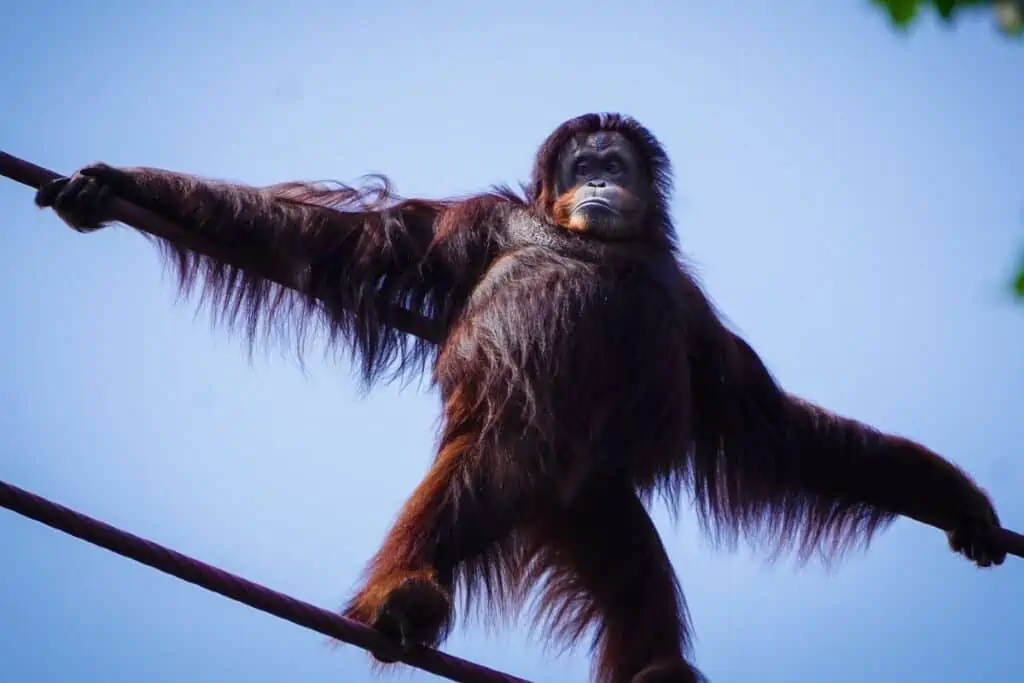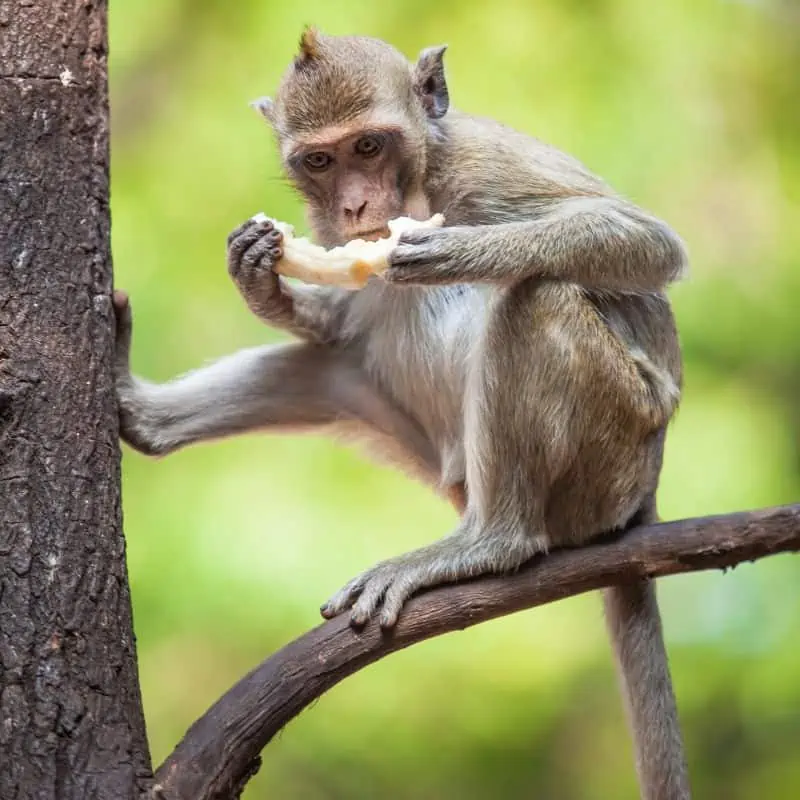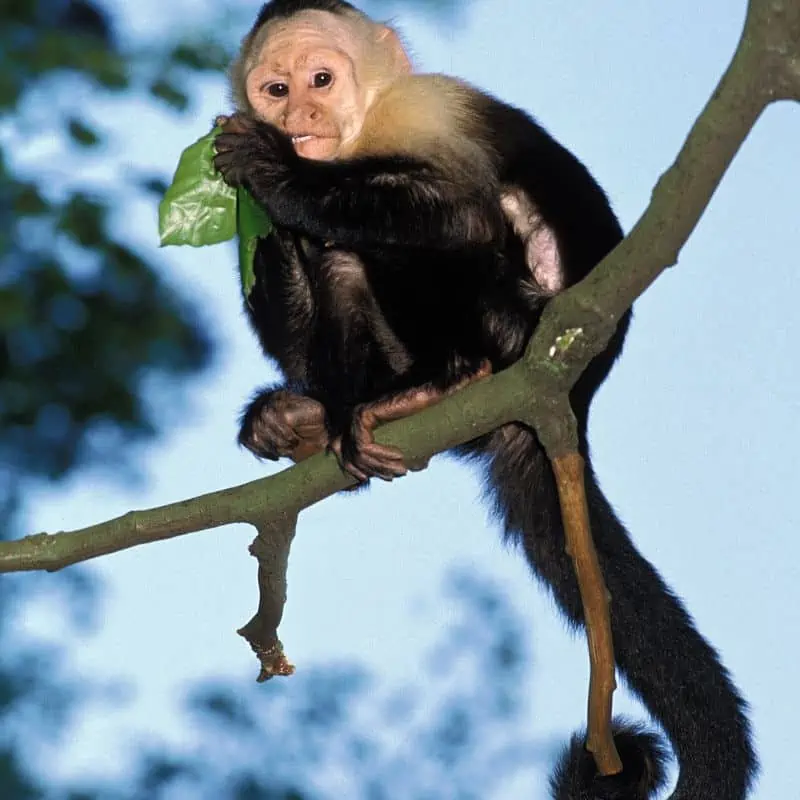Tails are ubiquitous throughout the kingdom Animalia. Some primates do possess tails to assist in smooth movement from tree to tree and balancing. Orangutans are great apes and the largest arboreal mammals on Earth, belonging to primates. So, do orangutans have tails as well?
Orangutans don’t have tails like other primates. Orangutans are apes, and unlike most monkeys, apes do not have tails. During evolution, tapering of the last sacral vertebrae and mutation in the TBXT jumping gene (involved in tail development) resulted in tail loss.
In this article, I’ll discuss the evolutionary history of the orangutan tail, the reasons for taillessness, and why they don’t need tails.

Orangutan’s Tail Facts
Approximately 20 million years ago, ape lineage evolved taillessness. Fossil records indicate that extinct apes were tailless, and scientists think all apes (extinct or living) are tailless.
Based on fossil evidence, Proconsul heseloni (the earliest ancestors to apes) lacked an external tail. In proconsul, the last sacral vertebra was tapered, so a tail could not be attached to it.
All ape fossils lacked a tail despite having some classic monkey-like traits.
The key thing to understand is the evolution of other physical traits accompanying that tail loss.
The evolution of new traits changed the movement of these animals and their interaction with the environment.
Why Don’t Apes Have Tails?
Orangutans mostly remain on trees, swinging from branch to branch by grasping vines and branches with their toes and long fingers.
A tail would be useful for them in balancing and precise movement, but it will be more of a hindrance than a blessing.
The loss of tails in apes (the superfamily that includes orangutans, gibbons, chimpanzees, gorillas, and humans) is due to the following main reasons.
Slow Cautious Movement
The slow, cautious movement, including multiple substrate contacts, eliminates the need for a tail.
Compared to extant monkeys, the morphology of early Miocene apes indicates modifications for slow and cautious movement.
Large Body Size
Due to the larger size of orangutans compared to monkeys, a tail would need to be massive to be beneficial. This theoretical large tail would then have more negatives than it would positives.
Carrying a tail would cause:
- Energy loss
- Increased predation risk
- Movement hindrances
Early Miocene apes are comparatively larger than monkeys, and it makes sense that the tail was not something that evolved with them.
TBXT Jumping Gene Mutation
Genetic data from nine species of monkeys and six species of great apes were compared to find differences linked to the absence and presence of the tail.
An Alu element or TBXT jumping gene was identified. It’s a short DNA piece capable of changing position in the genome and affecting protein production.
The TBXT jumping gene is linked to tail development and growth. In great ape species, the TBXT gene mutation was present, leading to the loss of the tail in apes.
This mutation was absent in monkeys.
Why Apes Don’t Need Tails
Tail loss is compensated by the other physical attributes that assisted apes in movement, including:
Upright Posture
Tail loss co-evolved with upright posture (orthograde posture) with independent movement of forelimbs and hindlimbs.
Orthograde primates evolved from pronograde primates (horizontal posture).
The number of vertebral segments in pronograde apes is 54-60 compared to primitive orthograde having 36 due to the compression of caudal vertebrae.
Tail loss and a shorter lumbar region automatically enabled the upright stance.
Fossil records confirm that pronograde primates also lacked tails but possessed horizontal postures.

Long Arms, Fingers, and Toes
Long arms, fingers, and toes are the physical traits accompanied by tail loss.
Apes use these structures to swing from branches and move swiftly from branch to branch. During swinging, legs and trunk hang below, illustrating an upright stance.
A tail can be a nuisance in this kind of locomotion.
Furthermore, apes have more dorsally situated shoulder scapula bones than monkeys, enabling apes to swing from their arms and raise them.
What Differentiates Apes From Monkeys?
Apes and monkeys are primates but are different from each other in many ways. These include:
- Apes are tailless, while almost all monkeys possess tails.
- Apes are large and possess shoulder joints (enabling them to swing from trees) and broad chests, while monkeys are narrow-chested and smaller.
- Apes also possess an appendix, while monkeys lack one.
- Apes are relatively more clever than monkeys and display some use of tools.
- Apes possess advanced language and cognitive skills (absent in monkeys). Monkeys and apes use gestures and sound to communicate.
The Function Of Tails In Monkeys
Besides the monkey’s distinctive feature, the prehensile tail is crucial for routine life.
Here are the essential functions of tails:
Assist in Balancing/Stabilization
Tails, in monkeys, aid in balancing the body while running, moving forward, sleeping, and jumping.
While monkeys climb over unstable branches, the tail aids in weight distribution.

Body Orientation
During leaping, tails are extended, assisting in preparation for landing and orienting the monkey’s body through the air.
A Fifth Limb
The monkey tail acts as a dexterous fifth limb.
While hanging from their hind limb, monkeys can brace/hold their body against a surface using their tail as an extra hand.
Navigation
The prehensile tail aids monkeys in navigating the treacherous and tall canopy in search of leaves and fruits.
The Tail As a Tool
Monkeys also use their tails as tools. For instance, Cebus capucinus (white-faced capuchins) utilize their tails to soak up water from a tree hole and drink water by sucking the fur.

Final Thoughts Tailless Orangutans
Orangutans, including other great apes, are tailless primates that evolved to have an upright posture, long arms, fingers, and toes with time, eradicating the need for a tail.
Other primates, like monkeys, have tails, aiding them in precise movement and balancing.
FAQs
Do Any Humans Have Tails?
During embryonic development, human embryos possess tails (vertebrae included). Most embryonic human tails vanish after about eight weeks through apoptosis.
What Kind of Monkey Has No Tail?
Macaques seem to be tailless, but they do possess a vestigial tail. As Macaques have evolved, the tail has disappeared as they do not require it.
What is the Longest Tail on A Human?
Chandre Oram from west Bengal, India, possessed the longest tail, about 33 cm (1 ft 1 in) long. It was a spina bifida case, not a true tail.
